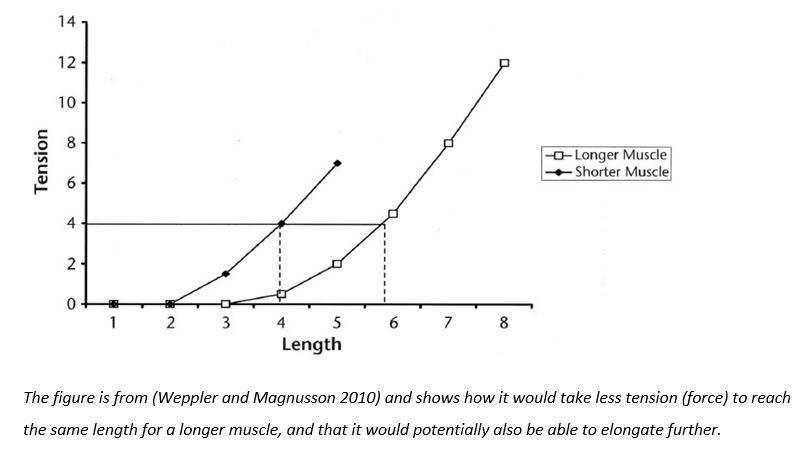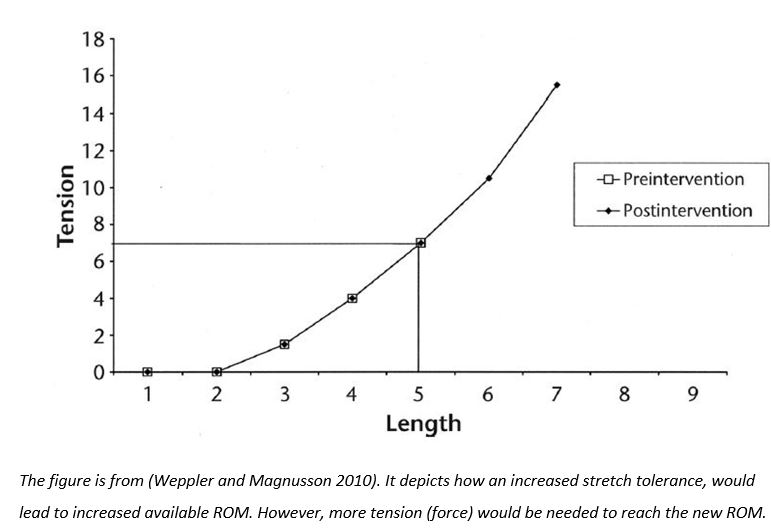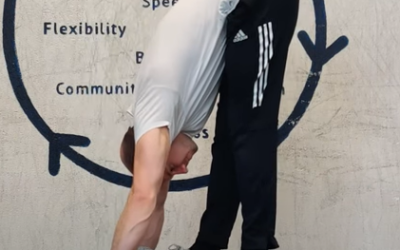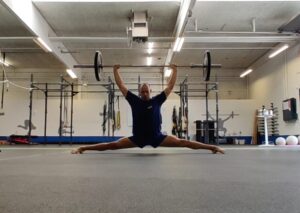When it comes to determining what adaptations lead to increased flexibility, two main theories have been proposed: The sensory theory, and the mechanical theory (Weppler and Magnusson 2010). To understand the difference, we’ll first need to discuss passive resistance to stretch.
Passive resistance to stretch: As you move a joint into the end ROM, there resistance to the stretch will increase, even if there is no muscle activation. This is because the muscles, tendons, ligaments, etc., works almost like elastic bands.
A decrease in passive resistance to stretch, would at least in theory have a positive effect on ROM – less force would be needed to reach a certain position the maximum ROM would most likely increase. For the passive resistance to decrease, some structures would have to adapt, either becoming longer, or less stiff. In accordance with this, several cross-sectional studies have found the flexible individuals have a lower passive resistance to stretch, than those less flexible (Blazevich et al. 2012; Abellaneda, Guissard, and Duchateau 2009; Moltubakk et al. 2018; Moltubakk et al. 2016; S.P. Magnusson et al. 1997).

Several studies have found that strength training can be effective in increasing fascicle length (G.E. McMahon et al. 2014a; G. McMahon et al. 2014b; Valamatos et al. 2018; Aquino et al. 2010); however strength training may also lead to stiffer tendons (Seynnes et al. 2009; Kongsgaard et al. 2007; Farup et al. 2014; Arampatzis, Karamanidis, and Albracht 2007) and increased pennation angle (Aagaard et al. 2001; Suetta et al. 2008; Reeves, Narici, and Maganaris 2004; Folland and Williams 2007; Bloomquist et al. 2013), which both contribute to increase the passive resistance to stretch. The effect of strength training on the passive resistance to stretch is therefore still relatively unclear.
Flexibility can also be increased without any change in passive resistance to stretch, or any structural adaptations occurring. In this case, the increase in flexibility can be explained by neural adaptions, the main adaptation being an increased stretch tolerance (Magnusson et al. 1996; Ben and Harvey 2010; P. Magnusson and Renström 2006; Ylinen et al. 2009; Halbertsma and Goeken 1994; S.P. Magnusson 1998; Weppler and Magnusson 2010).
Stretch tolerance is the ability to tolerate the stretching sensation – an increased stretch tolerance, would mean that stretching to a certain point, would feel less intense. It would thus be possible to stretch further, but getting to the new maximum ROM would also require more force to be applied.

Referencer:
Abellaneda, S., N. Guissard, and J. Duchateau. 2009. “The relative lengthening of the myotendinous structures in the medial gastrocnemius during passive stretching differs among individuals.” J Appl Physiol (1985) 106 (1): 169-77. https://doi.org/10.1152/japplphysiol.90577.2008.
Aquino, C. F., S. T. Fonseca, G. G. Goncalves, P. L. Silva, J. M. Ocarino, and M. C. Mancini. 2010. “Stretching versus strength training in lengthened position in subjects with tight hamstring muscles: a randomized controlled trial.” Man Ther 15 (1): 26-31. https://doi.org/10.1016/j.math.2009.05.006. https://www.ncbi.nlm.nih.gov/pubmed/19632878.
Arampatzis, A., K. Karamanidis, and K. Albracht. 2007. “Adaptational responses of the human Achilles tendon by modulation of the applied cyclic strain magnitude.” J Exp Biol 210 (Pt 15): 2743-53. https://doi.org/10.1242/jeb.003814. https://www.ncbi.nlm.nih.gov/pubmed/17644689.
Ben, M., and L. A. Harvey. 2010. “Regular stretch does not increase muscle extensibility: a randomized controlled trial.” Scand J Med Sci Sports 20 (1): 136-44. https://doi.org/10.1111/j.1600-0838.2009.00926.x. https://www.ncbi.nlm.nih.gov/pubmed/19497032.
Blazevich, A. J., D. Cannavan, C. M. Waugh, F. Fath, S. C. Miller, and A. D. Kay. 2012. “Neuromuscular factors influencing the maximum stretch limit of the human plantar flexors.” J Appl Physiol (1985) 113 (9): 1446-55. https://doi.org/10.1152/japplphysiol.00882.2012. https://www.ncbi.nlm.nih.gov/pubmed/22923509.
Bloomquist, K., H. Langberg, S. Karlsen, S. Madsgaard, M. Boesen, and T. Raastad. 2013. “Effect of range of motion in heavy load squatting on muscle and tendon adaptations.” Eur J Appl Physiol 113 (8): 2133-42. https://doi.org/10.1007/s00421-013-2642-7. https://www.ncbi.nlm.nih.gov/pubmed/23604798.
Farup, J., S. K. Rahbek, M. H. Vendelbo, A. Matzon, J. Hindhede, A. Bejder, S. Ringgard, and K. Vissing. 2014. “Whey protein hydrolysate augments tendon and muscle hypertrophy independent of resistance exercise contraction mode.” Scand J Med Sci Sports 24 (5): 788-98. https://doi.org/10.1111/sms.12083. https://www.ncbi.nlm.nih.gov/pubmed/23647357.
Folland, J. P., and A. G. Williams. 2007. “The adaptations to strength training : morphological and neurological contributions to increased strength.” Sports Med 37 (2): 145-68. https://doi.org/10.2165/00007256-200737020-00004.
Freitas, S. R., B. Mendes, G. Le Sant, R. J. Andrade, A. Nordez, and Z. Milanovic. 2017. “Can chronic stretching change the muscle-tendon mechanical properties? A review.” Scand J Med Sci Sports 28 (3): 794-806. https://doi.org/10.1111/sms.12957. https://www.ncbi.nlm.nih.gov/pubmed/28801950.
Freitas, S. R., and P. Mil-Homens. 2015. “Effect of 8-week high-intensity stretching training on biceps femoris architecture.” J Strength Cond Res 29 (6): 1737-40. https://doi.org/10.1519/JSC.0000000000000800. https://www.ncbi.nlm.nih.gov/pubmed/25486299.
Halbertsma, J. P., and L. N. Goeken. 1994. “Stretching exercises: effect on passive extensibility and stiffness in short hamstrings of healthy subjects.” Arch Phys Med Rehabil 75 (9): 976-81. https://www.ncbi.nlm.nih.gov/pubmed/8085933.
Kongsgaard, M., S. Reitelseder, T. G. Pedersen, L. Holm, P. Aagaard, M. Kjaer, and S. P. Magnusson. 2007. “Region specific patellar tendon hypertrophy in humans following resistance training.” Acta Physiol (Oxf) 191 (2): 111-21. https://doi.org/10.1111/j.1748-1716.2007.01714.x. https://www.ncbi.nlm.nih.gov/pubmed/17524067.
Magnusson, E. B. Simonsen, P. Aagaard, H. Sorensen, and M. Kjaer. 1996. “A mechanism for altered flexibility in human skeletal muscle.” J Physiol 497 ( Pt 1): 291-8. https://doi.org/10.1113/jphysiol.1996.sp021768. https://www.ncbi.nlm.nih.gov/pubmed/8951730.
Magnusson, Peter, and Per Renström. 2006. “The European College of Sports Sciences Position statement: The role of stretching exercises in sports.” European Journal of Sport Science 6 (2): 87-91. https://doi.org/10.1080/17461390600617865. https://doi.org/10.1080/17461390600617865.
Magnusson, S. P. 1998. “Passive properties of human skeletal muscle during stretch maneuvers. A review.” Scand J Med Sci Sports 8 (2): 65-77. https://doi.org/10.1111/j.1600-0838.1998.tb00171.x.
Magnusson, S. P., E. B. Simonsen, P. Aagaard, J. Boesen, F. Johannsen, and M. Kjaer. 1997. “Determinants of musculoskeletal flexibility: viscoelastic properties, cross-sectional area, EMG and stretch tolerance.” Scandinavian Journal of Medicine & Science in Sports 7 (4): 195-202. https://doi.org/https://doi.org/10.1111/j.1600-0838.1997.tb00139.x. https://onlinelibrary.wiley.com/doi/abs/10.1111/j.1600-0838.1997.tb00139.x.
McMahon, G., C. I. Morse, A. Burden, K. Winwood, and G. L. Onambélé. 2014b. “Muscular adaptations and insulin-like growth factor-1 responses to resistance training are stretch-mediated.” Muscle Nerve 49 (1): 108-19. https://doi.org/10.1002/mus.23884.
McMahon, Gerard E., Christopher I. Morse, Adrian Burden, Keith Winwood, and Gladys L. Onambélé. 2014a. “Impact of Range of Motion During Ecologically Valid Resistance Training Protocols on Muscle Size, Subcutaneous Fat, and Strength.” The Journal of Strength & Conditioning Research 28 (1): 245-255. https://doi.org/10.1519/JSC.0b013e318297143a. https://journals.lww.com/nsca-jscr/Fulltext/2014/01000/Impact_of_Range_of_Motion_During_Ecologically.32.aspx.
Moltubakk, M. M., O. Eriksrud, G. Paulsen, O. R. Seynnes, and J. Bojsen-Moller. 2016. “Hamstrings functional properties in athletes with high musculo-skeletal flexibility.” Scand J Med Sci Sports 26 (6): 659-65. https://doi.org/10.1111/sms.12488. https://www.ncbi.nlm.nih.gov/pubmed/26031482.
Moltubakk, M. M., M. M. Magulas, F. O. Villars, O. R. Seynnes, and J. Bojsen-Moller. 2018. “Specialized properties of the triceps surae muscle-tendon unit in professional ballet dancers.” Scand J Med Sci Sports 28 (9): 2023-2034. https://doi.org/10.1111/sms.13207. https://www.ncbi.nlm.nih.gov/pubmed/29723911.
Reeves, N. D., M. V. Narici, and C. N. Maganaris. 2004. “Effect of resistance training on skeletal muscle-specific force in elderly humans.” J Appl Physiol (1985) 96 (3): 885-92. https://doi.org/10.1152/japplphysiol.00688.2003.
Seynnes, O. R., R. M. Erskine, C. N. Maganaris, S. Longo, E. M. Simoneau, J. F. Grosset, and M. V. Narici. 2009. “Training-induced changes in structural and mechanical properties of the patellar tendon are related to muscle hypertrophy but not to strength gains.” J Appl Physiol (1985) 107 (2): 523-30. https://doi.org/10.1152/japplphysiol.00213.2009.
Simpson, C. L., B. D. H. Kim, M. R. Bourcet, G. R. Jones, and J. M. Jakobi. 2017. “Stretch training induces unequal adaptation in muscle fascicles and thickness in medial and lateral gastrocnemii.” Scand J Med Sci Sports 27 (12): 1597-1604. https://doi.org/10.1111/sms.12822. https://www.ncbi.nlm.nih.gov/pubmed/28138986.
Suetta, C., J. L. Andersen, U. Dalgas, J. Berget, S. Koskinen, P. Aagaard, S. P. Magnusson, and M. Kjaer. 2008. “Resistance training induces qualitative changes in muscle morphology, muscle architecture, and muscle function in elderly postoperative patients.” J Appl Physiol (1985) 105 (1): 180-6. https://doi.org/10.1152/japplphysiol.01354.2007. https://www.ncbi.nlm.nih.gov/pubmed/18420714.
Valamatos, M. J., F. Tavares, R. M. Santos, A. P. Veloso, and P. Mil-Homens. 2018. “Influence of full range of motion vs. equalized partial range of motion training on muscle architecture and mechanical properties.” Eur J Appl Physiol 118 (9): 1969-1983. https://doi.org/10.1007/s00421-018-3932-x. https://www.ncbi.nlm.nih.gov/pubmed/29982844.
Weppler, C. H., and S. P. Magnusson. 2010. “Increasing muscle extensibility: a matter of increasing length or modifying sensation?” Phys Ther 90 (3): 438-49. https://doi.org/10.2522/ptj.20090012.
Ylinen, J., T. Kankainen, H. Kautiainen, A. Rezasoltani, T. Kuukkanen, and A. Hakkinen. 2009. “Effect of stretching on hamstring muscle compliance.” J Rehabil Med 41 (1): 80-4. https://doi.org/10.2340/16501977-0283. https://www.ncbi.nlm.nih.gov/pubmed/19197574.
Aagaard, P., J. L. Andersen, P. Dyhre-Poulsen, A. M. Leffers, A. Wagner, S. P. Magnusson, J. Halkjaer-Kristensen, and E. B. Simonsen. 2001. “A mechanism for increased contractile strength of human pennate muscle in response to strength training: changes in muscle architecture.” J Physiol 534 (Pt. 2): 613-23. https://doi.org/10.1111/j.1469-7793.2001.t01-1-00613.x.


0 kommentarer